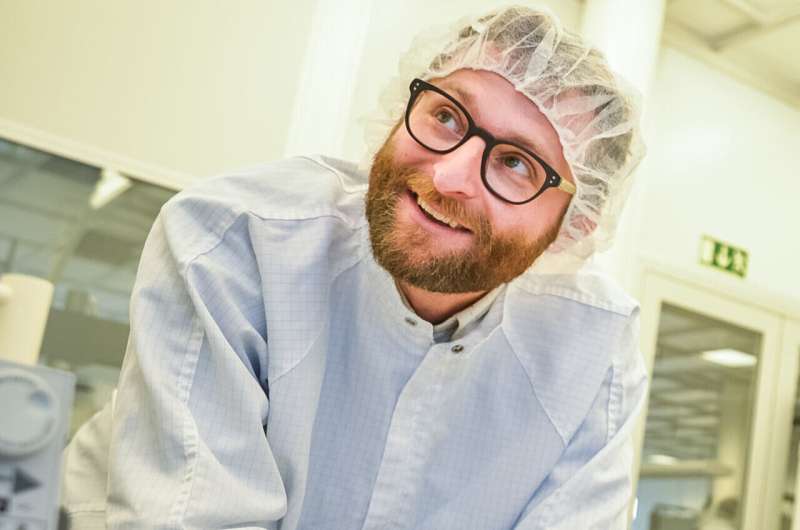Daniel Simon, associate professor in the Laboratory of Organic Electronics, Department of Science and Technology at Linköping University. Credit: Thor Balkhed
Researchers at Linköping University, Sweden, have developed a proton trap that makes organic electronic ion pumps more precise when delivering drugs. The new technique may reduce drug side effects, and in the long term, ion pumps may help patients with symptoms of neurological diseases for which effective treatments are not available. The results have been published in Science Advances.
Approximately 6% of the world's population suffer from neurological diseases such as epilepsy, Parkinson's disease, and chronic pain. However, currently available drug delivery methods—mainly tablets and injections—place the drug in locations where it is not required. This can lead to side effects that harm the patient.
"Organic electronic ion pumps have a huge potential for use in the treatment and diagnosis of neurological diseases. They could function in a similar manner to the insulin pumps already in use, but deliver the drug directly into the nervous system. Our most recent discovery is a proton trap that makes the amount delivered even more precise," says Daniel Simon, associate professor in the Laboratory of Organic Electronics, Department of Science and Technology at Linköping University.
Daniel Simon's research group has previously developed an organic electronic ion pump with delivery outlets as small as 20 x 20 micrometers. It should be possible to implant such devices to deliver drugs at exactly the desired location in the nervous system. The scientists hope that it will be possible to use the ion pump to discover and halt the development of neurological symptoms before the patient notices them.
Previous experiments were carried out on slices of mouse brain, using the naturally occurring signal substance GABA (gamma aminobutyric acid) as active drug. GABA is an inhibiting signal substance naturally found in the brain. When the amount of GABA increases, nerve cells are less likely to transfer nerve impulses to the next cell. A neurological seizure, such as occurs in epilepsy, in which the brain's nerve cells become overactive, is in this way prevented. When the ion pump is configured to transport GABA from an electrolyte reservoir outside the body to the desired location in the nervous system, a small voltage is used, which "pumps" the positively charged GABA through a transport channel. The method is known as electrophoresis. However, positive hydrogen ions, protons, from the electrolyte solution accompany the GABA through the channel. This leads to imprecise dosage and a drop in the pH of the tissue (making it more acidic), which can cause side effects.
The research group at Linköping University has now improved the ion pump. By introducing proton traps along the transport channel, the number of protons that pass can be considerably reduced. The proton trap consists of palladium, a noble metal that reacts readily—and nearly exclusively—with hydrogen and thus captures the positively charged protons. The proton traps mean that the ion pump can deliver a more precise dosage of the drug, since the potential applied corresponds almost exactly with the amount of GABA transported by the electrophoresis process.
"I believe that in a few years we will see organic bioelectronic ion pumps being used in the treatment of many neurological diseases. The proton trap can be integrated into all organic bioelectronic ion pumps, and our discovery has brought practical applications a lot closer," says Xenofon Strakosas, staff scientist and co-first-author with Maria Seitanidou, postdoc, both at the Laboratory of Organic Electronics, of the article in Science Advances.
More information: "An electronic proton-trapping ion pump for selective drug delivery" Science Advances, advances.sciencemag.org/lookup … .1126/sciadv.abd8738
Journal information: Science Advances
Provided by Linköping University
























